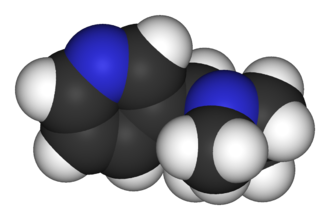Researchers from the Icahn School of Medicine at Mount Sinai have discovered a circuit in rats that links cigarette smoking and the risk of developing type 2 diabetes, according to a study featured on the cover of the October 17 issue of Nature.
Diabetes is far more prevalent in smokers than non-smokers, but the reasons why have remained unknown until now. The researchers showed that consumption of nicotine is linked, through a brain circuit, to the activity of the pancreas.
Nicotine use leads the pancreas to release less insulin, which raises the level of blood sugar; higher levels of blood sugar are associated with a higher risk of diabetes.
Specifically, the researchers found that a protein encoded by a diabetes-related gene called transcription factor 7 like 2 (Tcf7l2) mediates a signaling circuit that connects neurons in the brain activated by nicotine to blood-glucose regulation by the pancreas.
The nicotine activates nicotine acetylcholine receptor (nAChR) proteins expressed on neurons in the medial habenula (a brain area that regulates aversive reactions to nicotine), leading to adverse responses to nicotine that limit both intake and the release of glucagon and insulin by the pancreas.
This, in turn, raises the levels of blood sugar, and the raised levels of blood sugar create a feedback loop by inhibiting the nAChR-expressing neurons, blocking adverse responses to smoking and so helping to establish nicotine dependence. Tcf7l2 modulates the entire signaling circuit, thereby linking nicotine addiction with an increased risk of diabetes.
Continue Reading Below ↓↓↓
“Our findings are important because they describe a mechanism that controls the addictive properties of nicotine and, surprisingly, show that the same addiction-related brain circuits also contribute to smoking-related diseases previously thought to be related to the actions of tobacco outside the brain,” says Paul J. Kenny, PhD, Ward-Coleman Professor and Chair of the Nash Family Department of Neuroscience at the Icahn School of Medicine at Mount Sinai and senior author of the paper. “These unexpected findings suggest that at least some of the disease-causing actions of nicotine arise in the brain by the very same circuits that control the addictive properties of the drug. This means that the addictive and disease-causing actions of tobacco may, in some cases, share the very same underlying mechanisms.”
While previous research had shown that Tcf712 regulates the expression of genes in the pancreas and liver that determine blood glucose levels and the risk of developing type 2 diabetes, little was known about its function in the brain. To investigate the association between Tcf712, nicotine addiction, and blood glucose regulation, researchers genetically deleted Tcf712 in rats.
The mutant rats consumed much greater quantities of nicotine than animals in which Tcf7l2 functioned normally. Deletion of Tcf7l2 resulted in diminished nicotinic receptors in the medial habenula and consequently, reduced ability of nicotine to activate the habenula’s aversion circuit. Unexpectedly, while the loss of Tcf712 function in the habenula increased nicotine consumption in rats, this change also reduced nicotine-driven blood glucose increases and protected against the emergence of diabetes-associated abnormalities in blood glucose levels.
“This unanticipated finding suggests a link between nicotine use and the onset of type 2 diabetes, with implications for future prevention and treatment strategies for both diseases,” said Nora D. Volkow, MD, Director of the National Institute on Drug Abuse, which funded the study. “Although addiction is a brain disease, this discovery underscores how the body’s complex functions are exquisitely interconnected, revealing the need for integrated and innovative research.”
If these findings in rats extend to human cigarette smokers, they suggest a dynamic in which variations in the Tcf712 gene might influence both the risk of tobacco addiction and the development of tobacco-associated type 2 diabetes. More broadly, the findings suggest that type 2 diabetes–and perhaps other cigarette smoking-related diseases in which abnormalities in the autonomic nervous system play a role, such as hypertension and cardiovascular disease–originate in the brain and implicate nicotine-induced disruptions of the interactions between the habenula and the peripheral nervous system.
“Our findings will help guide the search for new anti-smoking medications and also suggest that a particular circuit in the brain may be targeted to treat diabetes in smokers and, perhaps, even in non-smokers,” said Dr. Kenny.
Researchers from The Scripps Research Institute, Medical College of Wisconsin, and Rockefeller University contributed to this work.
The study was supported by the grants from the National Institute on Drug Abuse.
SOURCE: Icahn School of Medicine at Mount Sinai, Eurekalert
JOURNAL: Nature
FUNDER: NIH/National Institute on Drug Abuse











